IDEX Online Research: Polished Diamond Prices Mostly Steady in March
April 02, 09
Much like stock prices on the world’s financial markets, polished diamond prices appear to have stabilized in the past month or so, based on the IDEX Online Polished Diamond Price Index. Average polished diamond prices declined in March 0.6 percent versus average diamond prices during February and dipped by 7.3 percent versus March 2008.
In one or two specific categories, prices seem to be inching up, though it is far too soon to call this a trend. However, there was some price weakness – which we view as temporary – at the end of March.
Prices of larger diamonds – 3 carats and up – appear to have stabilized around the long term trend line, after their price bubble burst in late 2008. While prices of smaller diamonds – 2 carats and lower – appear to be in a holding pattern, they are selling at prices below their long term trend line.
We believe that demand for larger diamonds may have stabilized for two reasons: 1) investors have been focusing on larger stones; and, 2) very high-end old-money consumers are not as pinched as newly wealthy consumers who had been buying large stones. It appears that some of these old-money shoppers are in the market seeking bargains in superior quality polished diamonds.
On the other hand, in the
Overall, despite negative numbers, the sales figures for
Further, there are anecdotal signs that the American consumer – optimistic by culture – has had enough bad news. The media is being bashed for being so negative. For example, Stephen Joyce, CEO of Choice Hotels (5,800 hotels with 470,000 rooms), said, “When we stop barraging people with bad news, they will take a deep breath and go back to work.” (Financial Times,
Consumer confidence is not a harbinger of consumer demand – despite what the mass media claims – but it appears to have stabilized in March. At least, consumers aren’t feeling any worse.
In our opinion, we are probably past the worst of the recessionary environment. In the
Because of the strength and resilience of the American economy, we believe that diamantaires who have deserted this huge market – representing an estimated 50 percent of global diamond sales – in search of emerging markets elsewhere in the world may have made a strategic error. There may be pockets of vibrancy here and there in overseas markets, but the aggregate spending power of consumers in those markets is far too small to make them viable for diamantaires over the long term.
March Polished Diamond Price Trends Encouraging
Based on March data, polished diamond prices are no longer in a free fall, according to the IDEX Online Global Diamond Price Index. After peaking last summer, polished diamond prices declined sharply beginning in October 2008, a trend that continued through January. However, while diamond prices softened during the last week of March – a temporary anomaly, in our opinion – they have stabilized from prior months’ weakness.
While diamond prices fell through the long term trend earlier this year, we are not particularly concerned. Actual prices move up and down to generate what mathematicians call a “sine wave.” Much like waves in the ocean, prices are characterized by sine waves which surge, reach a peak, then pull back substantially, only to build, surge, and wane again. We believe that we may be near the bottom of the sine wave for polished diamond prices, based on a mathematical analysis of the current diamond price trend line. Will reality follow the mathematical projection? Only time will tell. (Still confused about a “sine wave?” Google it and read Wikipedia’s explanation.)
The graph below summarizes polished diamond price trends over the past two years.
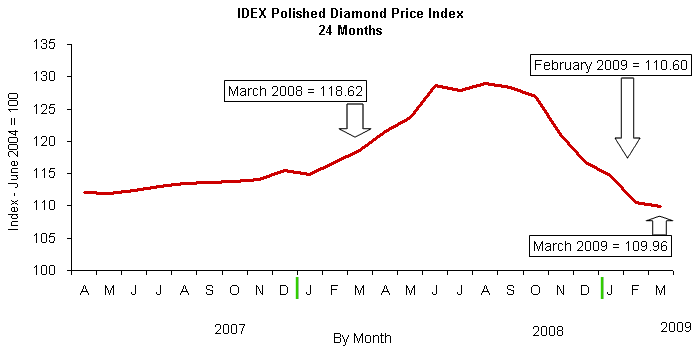
Source: IDEX Online Research
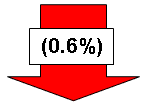 |
March 2009 versus February 2009: (0.6 percent)
Further, it reflects a general stabilizing of financial and commodities markets around the world. Diamond prices began to soften in the early fall of 2008, after almost six months of unusually high inflationary pricing for polished stones.
On an annualized basis, March’s price decline represents about a 7 percent annual deflation rate for polished diamonds. Compared to prior months – February’s decline was about 50 percent on an annualized basis – March’s price decline is a welcome respite from the bad news coming out of the market in recent months.
The current deflationary trend is beneficial to downstream participants in the diamond pipeline since their margins have been squeezed for sometime, with a particular tightening in 2008.
We believe history is a great forecaster for the future. As we have seen in March, the rate of diamond price deflation has begun to moderate. The longer term inflation rate will return, in our opinion, perhaps this year or by 2010. The IDEX Online Polished Diamond Price Index, calculated on the average daily, stood at 109.96 for the month. At the end of March, the IDEX Online Polished Diamond Price Index had slipped to 109.17, reflecting weakness that we view as temporary. The IDEX Online Polished Diamond Price Index stood at 100.00 in July 2004.
The graph below summarizes month-over-month changes in global diamond prices for the past thirteen months. Beginning in the first quarter of 2008, polished diamond prices showed large gains during every month in the first half of the year. Since then, prices have generally decreased as consumer demand has weakened.
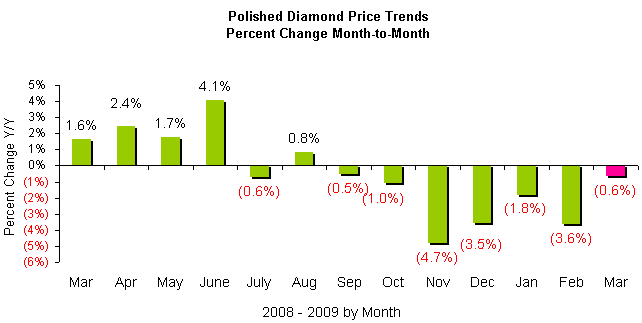
Source: IDEX Online Research
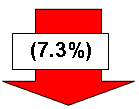 |
On a year-over-year basis, global polished diamond prices dipped by 7.3 percent in March versus March 2008. This was the ninth consecutive month of deceleration of year-over-year price increases for polished diamonds, and it was the third month that year-over-year prices dipped. At first glance, March’s year-over-year deep price decline appears to be worrisome, but upon further examination, it is less of a concern. Polished diamond prices began their surge in March of 2008, so comparisons against those “bubble” prices look unfavorable. In subsequent months, we could continue to see significant percentage declines, but they are more of a mathematical anomaly than a reflection of reality. While this measure has dipped below the historical trend line annual inflation rate of 3-4 percent, we believe that diamond prices will return to their historic annual inflation in the future.
The historical inflation rate is sustainable, in our opinion, over the long term. While some forecasters are predicting a “new economy,” diamonds and diamond demand have remained more or less on the sidelines during the recent turmoil in the commodities markets. Thus, we believe that they are more likely to remain relatively untouched in the future, once the
Comparisons in the graph below are based on the daily average prices during the month versus the same month a year. The year-to-year comparison takes into account the seasonality of polished diamond demand and prices.
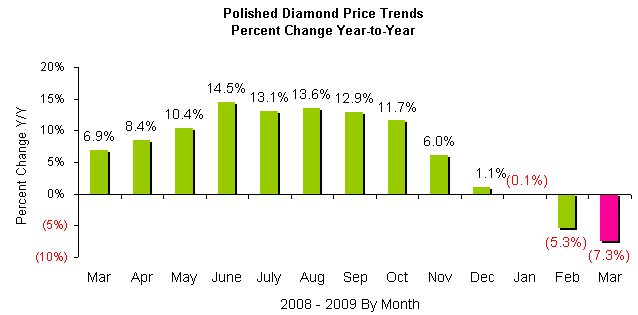
Source: IDEX Online Research
Prices of Larger Diamonds Stabilizing
The graph below summarizes the long term price trends for various sizes of polished diamonds. In March, price declines slowed, especially among the larger diamond sizes – 3 carat and above.
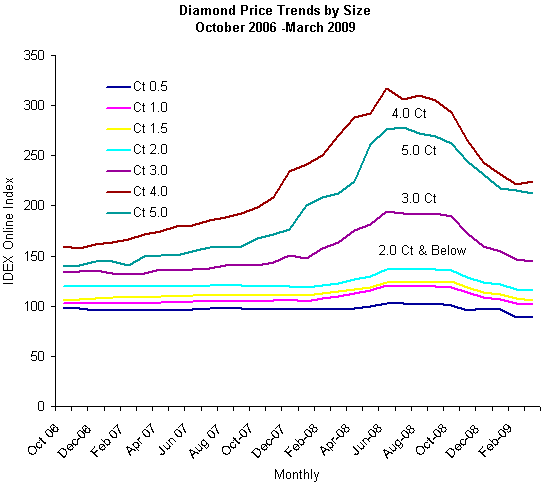
Source: IDEX Online Research
Forecast: Diamond Prices May Be Stabilizing
We’ve been surprised to see that the descent of polished diamond prices has slowed. We had been forecasting further significantly softening. But, as they say on Wall Street, “don’t fight the tape.” The polished diamond price trends we’ve seen in February and March are encouraging. Diamond prices have remained far less volatile than stock prices, so we think the current trends may suggest that the market has about reached bottom. Unlike the stock market which will continue to test historic lows before it moves solidly into bull territory, diamond prices don’t move quickly, and thus, won’t be testing for the low point.
It’s not time to celebrate, but unless we get some surprises in April and May, we may have seen the worst.
The IDEX Online Diamond Price Index
The IDEX Online Diamond Price Index is a real-time index derived from actual asking prices in the global diamond industry. The IDEX Online Diamond Price Index objectively reflects price trends as they happen. The Diamond Index and Diamond Drivers were formulated following comprehensive research and analysis of the IDEX Online inventory database, aggregated since 2001. Research and development were conducted in cooperation with Dr. Avi Wohl, Senior Lecturer of Finance at the faculty of Management,
Additional information is available from IDEX Online Research. The e-mail address is diamondprices at idexonline dot com.